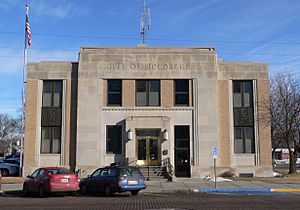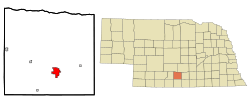Holdrege, Nebraska facts for kids
Quick facts for kids
Holdrege, Nebraska
|
|
|---|---|

Holdrege city hall
|
|

Location of Holdrege, Nebraska
|
|
| Country | United States |
| State | Nebraska |
| County | Phelps |
| Area | |
| • Total | 4.24 sq mi (10.98 km2) |
| • Land | 4.23 sq mi (10.95 km2) |
| • Water | 0.01 sq mi (0.04 km2) |
| Elevation | 2,326 ft (709 m) |
| Population
(2020)
|
|
| • Total | 5,515 |
| • Density | 1,305.02/sq mi (503.87/km2) |
| Time zone | UTC-6 (Central (CST)) |
| • Summer (DST) | UTC-5 (CDT) |
| ZIP code |
68949
|
| Area code(s) | 308 |
| FIPS code | 31-22640 |
| GNIS feature ID | 838058 |
| Website | www.cityofholdrege.org |
Holdrege is a city in Phelps County, Nebraska, United States. It is the main town and the county seat of Phelps County. This means it is where the county government offices are located. In 2020, about 5,515 people lived there. The Nebraska Prairie Museum is also in Holdrege.
Contents
Discovering Holdrege's Past
Holdrege was started in 1883. This happened when the railroad lines were built to reach that area. The city was named after George Ward Holdrege. He was an important official for the railroad company.
How Holdrege Became a City
Many of the first settlers in Holdrege were immigrants from Sweden. They arrived in the 1880s. George Ward Holdrege was the general manager of the Chicago, Burlington, and Quincy Railroad Company. He built many railroad tracks in Nebraska. One section went right through this small settlement.
The very first train arrived in Holdrege on December 10, 1883. At that time, only about 200 people lived in the pioneer town.
Becoming the County Seat
In 1884, people in Holdrege wanted their town to be the county seat. The county seat is the main town where the county government is located. Before this, Phelps Center was the county seat. An election was planned for October.
Holdrege had already set aside land for a courthouse. They were sure they would win the election. They even laid the first stone for the building. Holdrege won the election by a majority of votes. However, some people questioned if the election was fair.
So, citizens from Holdrege went to Phelps Center. They took the official records and books. They hid them for two months. This was until new county officials took over in January 1885. Holdrege successfully became the county seat. The courthouse was then finished.
Growth and Development of Holdrege
Holdrege officially became a city on February 14, 1884. It quickly became the most important town in the county. It was easy to reach from all directions.
The early years of the town had their ups and downs. Some years had good crops. Other years had droughts, meaning no crops at all. In 1910, a grain dealer named C. W. McConaughy had an idea. He wanted to use water from the Platte River to help local farms.
His idea came true in 1941. The Central Nebraska Public Power and Irrigation District started its operations. Water began flowing into Phelps County for irrigation. This helped farmers grow more crops.
After World War II, Holdrege's population grew a lot. This was mainly because of irrigation. More water meant more stable and increased crop production. This brought new businesses to town. These included a pipeline company and grain elevators. Holdrege was declared a "first-class city" on May 4, 1967.
Exploring Holdrege's Location and Weather
Holdrege covers a total area of about 3.87 square miles (10.02 square kilometers). Most of this area is land. Only a very small part is water.
What is the Climate Like?
Holdrege, Nebraska, experiences a wide range of temperatures. Summers can be quite hot. Winters are generally cold. The area also receives a fair amount of precipitation throughout the year. This includes both rain and snow.
| Climate data for Holdrege, Nebraska (1991–2020 normals, extremes 1897–present) | |||||||||||||
|---|---|---|---|---|---|---|---|---|---|---|---|---|---|
| Month | Jan | Feb | Mar | Apr | May | Jun | Jul | Aug | Sep | Oct | Nov | Dec | Year |
| Record high °F (°C) | 74 (23) |
79 (26) |
92 (33) |
101 (38) |
103 (39) |
110 (43) |
113 (45) |
110 (43) |
105 (41) |
96 (36) |
88 (31) |
80 (27) |
113 (45) |
| Mean maximum °F (°C) | 59.2 (15.1) |
64.8 (18.2) |
76.7 (24.8) |
84.0 (28.9) |
91.1 (32.8) |
96.3 (35.7) |
99.0 (37.2) |
96.3 (35.7) |
93.1 (33.9) |
86.7 (30.4) |
72.8 (22.7) |
60.9 (16.1) |
99.9 (37.7) |
| Mean daily maximum °F (°C) | 36.7 (2.6) |
40.6 (4.8) |
52.4 (11.3) |
62.4 (16.9) |
72.2 (22.3) |
83.2 (28.4) |
87.3 (30.7) |
85.1 (29.5) |
78.5 (25.8) |
65.2 (18.4) |
50.9 (10.5) |
39.1 (3.9) |
62.8 (17.1) |
| Daily mean °F (°C) | 25.0 (−3.9) |
28.3 (−2.1) |
38.7 (3.7) |
48.6 (9.2) |
59.2 (15.1) |
70.3 (21.3) |
74.8 (23.8) |
72.7 (22.6) |
64.7 (18.2) |
51.4 (10.8) |
37.9 (3.3) |
27.6 (−2.4) |
49.9 (10.0) |
| Mean daily minimum °F (°C) | 13.2 (−10.4) |
15.9 (−8.9) |
24.9 (−3.9) |
34.9 (1.6) |
46.3 (7.9) |
57.3 (14.1) |
62.4 (16.9) |
60.2 (15.7) |
50.9 (10.5) |
37.6 (3.1) |
24.9 (−3.9) |
16.2 (−8.8) |
37.1 (2.8) |
| Mean minimum °F (°C) | −4.8 (−20.4) |
−1.5 (−18.6) |
7.8 (−13.4) |
22.1 (−5.5) |
33.0 (0.6) |
47.4 (8.6) |
53.5 (11.9) |
51.2 (10.7) |
37.9 (3.3) |
22.0 (−5.6) |
9.1 (−12.7) |
−0.7 (−18.2) |
−9.3 (−22.9) |
| Record low °F (°C) | −22 (−30) |
−28 (−33) |
−14 (−26) |
4 (−16) |
19 (−7) |
37 (3) |
42 (6) |
42 (6) |
23 (−5) |
4 (−16) |
11 (−12) |
−29 (−34) |
−29 (−34) |
| Average precipitation inches (mm) | 0.56 (14) |
0.69 (18) |
1.63 (41) |
2.81 (71) |
4.42 (112) |
3.90 (99) |
4.23 (107) |
3.59 (91) |
2.08 (53) |
2.03 (52) |
0.94 (24) |
0.71 (18) |
27.59 (700) |
| Average snowfall inches (cm) | 5.6 (14) |
7.0 (18) |
3.9 (9.9) |
1.8 (4.6) |
0.2 (0.51) |
0.0 (0.0) |
0.0 (0.0) |
0.0 (0.0) |
0.0 (0.0) |
0.8 (2.0) |
2.0 (5.1) |
4.1 (10) |
25.4 (64.11) |
| Average precipitation days (≥ 0.01 in) | 3.3 | 3.9 | 5.8 | 7.9 | 10.8 | 9.1 | 7.9 | 7.8 | 6.0 | 5.5 | 3.7 | 3.1 | 74.8 |
| Average snowy days (≥ 0.1 in) | 2.9 | 3.1 | 1.9 | 0.8 | 0.0 | 0.0 | 0.0 | 0.0 | 0.0 | 0.4 | 1.1 | 2.6 | 12.8 |
| Source: NOAA | |||||||||||||
Understanding Holdrege's Population
The population of Holdrege has changed over the years. It has generally grown since it was founded. The city has seen periods of rapid growth. This often happened when new resources or jobs became available.
| Historical population | |||
|---|---|---|---|
| Census | Pop. | %± | |
| 1890 | 2,601 | — | |
| 1900 | 3,007 | 15.6% | |
| 1910 | 3,030 | 0.8% | |
| 1920 | 3,108 | 2.6% | |
| 1930 | 3,263 | 5.0% | |
| 1940 | 3,360 | 3.0% | |
| 1950 | 4,381 | 30.4% | |
| 1960 | 5,226 | 19.3% | |
| 1970 | 5,635 | 7.8% | |
| 1980 | 5,624 | −0.2% | |
| 1990 | 5,671 | 0.8% | |
| 2000 | 5,636 | −0.6% | |
| 2010 | 5,495 | −2.5% | |
| 2020 | 5,515 | 0.4% | |
| U.S. Decennial Census 2012 Estimate |
|||
What the 2020 Census Shows
The 2020 United States census counted 5,515 people in Holdrege. There were 2,438 households. Most people living in Holdrege are white. There are also people from other racial backgrounds. About 8% of the population is Hispanic or Latino.
The average age in Holdrege is around 40.4 years old. About 21% of the population is under 18. About 20.5% of the population is 65 or older.
Places to Visit in Holdrege
The main attraction in Holdrege is the Nebraska Prairie Museum. It's a great place to learn about the history of the area.
How to Get Around Holdrege
Holdrege has important roads that pass through it. US 183 goes north and south. US 6 and US 34 go west and east.
Public Transportation Options
The Phelps County Senior Center runs a bus system. This helps people get around town. Amtrak, the national passenger train system, also serves Holdrege. The California Zephyr train stops here daily. It travels between Chicago and Emeryville, California. Emeryville is near San Francisco.
Famous People from Holdrege
Many notable people have connections to Holdrege. These individuals have made contributions in various fields.
- Tom Carlson, a member of the Nebraska Legislature.
- Mark R. Christensen, also a member of the Nebraska Legislature.
- Joseph P. Cleland, a U.S. Army major general. He received the Soldier's Medal.
- Ralph D. Cornell, a well-known landscape architect.
- Barbara Granlund, who served in the Washington House of Representatives and Washington State Senate.
- Jerry Johnson, another member of the Nebraska Legislature.
- DiAnna Schimek, a member of the Nebraska Legislature.
- Harry Schmidt, a U.S. Marine Corps general. He was a commanding general during the Mariana Islands Campaign.
See also
 In Spanish: Holdrege (Nebraska) para niños
In Spanish: Holdrege (Nebraska) para niños

